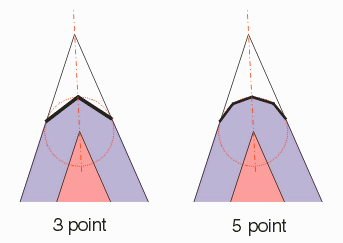Sizing Polygons
A commonly needed operation in the mask design business is to size up (or down) each polygon by a given amount. Sizing may be done to account for process shrinkage or it may be done in order to create a "derived" layer. In any event the ability to size thousands or even millions of polygons quickly and efficiently is built into the boolw32f engine.

The operation code for sizing is -size:XX where XX is the amount of sizing measured perpendicular from each edge.
Suppose we have a GDSII file, in.gds, in units of microns, and we want to size up all of the polygons on layer 7 by 0.25 um. We want to output the results out.gds on layer 9. Then the command line would be:
boolw32f in.gds out.gds TOP 9 +7-sizing:0.25

